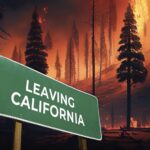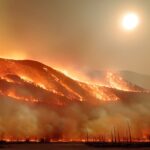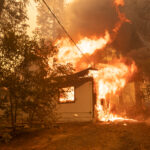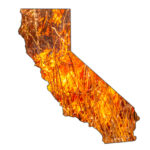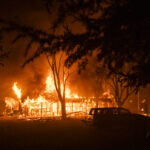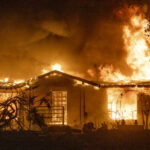The topic of a recent California insurance department workshop was the potential use of catastrophe modeling in ratemaking, but carrier representatives and consumers took the opportunity to air concerns about other problems in the state’s insurance market.
The state’s growing availability crisis is poised to get worse unless changes beyond the introduction of forward-looking catastrophe modeling to ratemaking take hold, carrier executives said.
“Change is critical to restoring the health to the California insurance marketplace and [to] avoiding increased nonrenewals and further carrier withdrawals from the state,” said Parr Schoolman, chief risk officer of Allstate Property and Liability, during the four minutes of remarks he delivered during a four-hour public workshop that was broadcast via Zoom and Facebook on July 13. Among the changes Schoolman advocated were actions to speed up rate filing approvals and to allow insurers to include the costs of reinsurance in their rate indications.
“Allstate would prefer to material[ly] re-enter the property market by offering new policies to the vast majority of consumers. We’d expect we’d be able to target at least 90 percent of the available market in terms of availability, with the inclusion of wildfire catastrophe modeling and reinsurance costs being allowed in the setting of premiums.”
“Without pricing enhancements, Allstate will remain closed to new business and will evaluate additional nonrenewals or the full withdrawal of property lines from the California market,” he stated, concluding his testimony.
More Than Cat Models
In early June, the department of insurance announced the workshop, calling for public input on technical and legal questions surrounding the use of catastrophe models for pricing wildfire risks. Specifically, the June notice asked for testimony about Section 1861.07 of the California insurance code, which states that “all information provided to the commissioner” in connection with a rate filing application needs to be “available for public inspection.” Recognizing the shortcomings of the method that has been used for estimating catastrophe adjustments for decades—the use of historical catastrophe losses—the department sought opinions on how cat model factors and sensitive inner workings could be opened up for scrutiny in accordance with the law.
After representatives of some of the best-known cat modeling firms talked about the need to balance transparency of inputs and outputs with intellectual property protections, and after consumer representatives alleged cat models are just an excuse for insurers to push pricing up, testimony at the mid-July workshop started to move away from the topic at hand—Section 1861.07. Community leaders, condo board members and insurance agents gave vivid, on-the-ground perspectives of what it feels like to live through what many referred to as “a crisis,” pleading with carriers to recognize their mitigation efforts in any pricing models they might adopt. (Carrier Management’s third-quarter magazine will provide more detail from the testimony of community leaders, consumer representatives and agents.)
Only three presenters spoke directly on behalf of the carriers they work for—two from Allstate and one from CSAA—expressing the desire to continue to provide coverage for homeowners in California and offering examples of how their attempts to comply with current rate filing regulations have prompted them to retreat. (Another carrier employee, an actuary who didn’t reveal his affiliation with a specialty carrier, spoke more squarely about how catastrophe models could be used to create schedules of concentration charges measuring the risk to carrier surplus.)
Ryan Vigus, executive vice president of Personal Lines at CSAA Insurance Group, a AAA insurer, explained that regulations currently require all insurers to use a simple catastrophe model based on at least 20 years of historical actual experience. (Editor’s Note: Other speakers said this rule is the catastrophe adjustment provision of the California Code of Regulation, § 2644.5.)
According to Vigus, after the Valley and Butte fires in 2015, CSAA filed a new wildfire cat load as required by law, calculating a figure of $48 million per year based on two decades of actual loss experience. “Despite following all the requirements of the regulations, we were forced to accept a rate that reflected a lower catastrophe load of $38 million.”
“That was because the 1991 Oakland Hills fire was judgmentally reduced to a so-called 1-in-50 event.”
“This is a 21 percent reduction in the wildfires load already allowed in the current ratemaking formula,” he said, going on to cite a second example, a $162 million calculation using the CDI formula after the 2017 North Bay fires and 2018 Paradise fire. That one was reduced by $20 million to $142 million during the rating approval process “because, and I quote, ‘Our exposures had changed,’ end quote. But we were not allowed to increase the load to account for climate change, which is clearly leading to increased [risk]. That’s a 12 percent reduction in the wildfire catastrophe load despite the risk clearly increasing over time,” Vigus said.
“This leads to inadequate rates and is the significant contributor to the current insurance crisis.”
“Adding new allowable methodologies will not be useful if they’re artificially suppressed in the rate approval process like current methodologies are today.”
“I’m sharing these examples because we believe CDI has the opportunity to approve more adequate rates under methodologies already allowed by regulation. Today’s hearing is focused on third-party models, very sophisticated models that go beyond past experience to include future-looking forecasts. And we support them, particularly in light of climate change. However, adding new allowable methodologies will not be useful if they’re artificially suppressed in the rate approval process like current methodologies are today.”
“CSAA wants to continue to write California customers, but no company can offer products that lose money over the long run because the company will simply cease to exist,” he said.
Schoolman and several representatives from carrier and agent trade groups underscored the idea that it’s not just the inability to use catastrophe models that has them exiting the state. Schoolman noted, in fact, that carriers are actually currently allowed to use catastrophe models to determine cat loads for earthquake, including fire-following earthquake exposure. “Approximately 60-70 percent of single-family households in California are located in moderate to high fire-following earthquake exposure. Major population centers like San Francisco and Los Angeles are near major fault lines. While we can leverage catastrophe models to develop a fire-following earthquake catastrophe loss provision there, we still fall short on insurance premiums by not allowing the cost of reinsurance for those exposures,” he said.
The cost of reinsurance “is a significant portion of our underlying cost of doing business. In addition, we have restrictions on the rate of return and the profit factors allowed, and there’s an abnormally long filing review and approval timeline in rate filing,” Allstate’s CRO said, reporting that the carrier’s most recent home filing took 773 days to approve.
Adding the inability to reflect prospective wildfire loss costs from catastrophe models to the list, Schoolman said that as a result of all these barriers, “Allstate’s average policy premium in California is at a level 43 percent lower than many other states with high risk for catastrophic events such as Colorado, Florida, Louisiana and Texas,” speaking a week before Allstate announced that $2.7 billion in catastrophe losses across the country will be reflected the insurer’s second-quarter results.
He continued, “Allstate would prefer to material[ly] re-enter the property market by offering new policies to the vast majority of consumers. We’d expect we’d be able to target at least 90 percent of the available market in terms of availability, with the inclusion of wildfire catastrophe modeling and reinsurance costs being allowed in the setting of premiums.”
“Enabling carriers to more adequately match premiums to risk, we’ll increase insurance availability within the voluntary market, and it should lead to depopulation of the FAIR plan. Allstate, and we expect other carriers as well, will be leveraging the FAIR plan as a clearinghouse program to offer voluntary market policies when rates are sufficient,” he said.
Bottom line: “Allstate is dedicated to serving the insurance needs of Californians and would prefer to grow our market share in the state. However, longstanding restrictions are preventing the ability to appropriately match insurance premiums to the risks they present to Allstate,” he said.
Later at the workshop, Stephen Young, senior vice president and general counsel of the Independent Insurance Agents and Brokers of California, said that getting credit for reinsurance expenses is the most important factor in a four-part plan to get insurance companies to start writing and renewing property risks in the state again, referencing the findings of a national law firm and national actuarial experts that IIABCal commissioned to develop such a plan.
The second most important factor is allowing a cost of capital component for the catastrophic exposures that were not ceded to reinsurance. The third dealt with rate modeling, and the fourth element simply concerned the time that it takes the DOI to approve rate filings, he said.
“It is telling to us that the factors driving these catastrophic wildfire exposures are present in virtually every western state, and yet only California seems to have the availability crisis of the magnitude that we are experiencing,” he said. “And I can tell you that our members who sell insurance in every part of this state are telling us this is the greatest and most severe availability crisis any of them have experienced in their long careers. This is a crisis, and certainly a lot of attention has been given to recent decisions by the market leaders like State Farm, Allstate, Farmers, but long before they made their decisions, independent agency companies had already been shotgun nonrenewing policies, terminating agency appointments and doing other things to restrict their writing,” he stated.
“Fundamentally what insurers need is prompt approval of their rate requests and adequate rates. And, in too many cases, we believe companies cannot get either from this department of insurance right now,” he said.
Young did not reveal the name of the law firm or actuaries involved in developing the plan when he spoke.
Separately, late last year, the Personal Insurance Federation of California, the American Property Casualty Insurance Association and the National Association of Mutual Insurance Companies released an analysis from actuarial firm Milliman addressing the potential impact of allowing wildfire catastrophe model results to be used in the California homeowners ratemaking formula. Milliman found, among other things, that cat model indications could deliver less jarring changes in rates over time than the use of historical experience and could allow carriers to incorporate mitigation impacts into pricing most quickly.
Representatives of PIF, APCIA, NAMIC and Milliman all spoke during the July 13 workshop as well, with the trade group representatives reiterating the calls for the inclusion of reinsurance costs and timely filing approval, and the Milliman actuaries describing how other states structure the review of catastrophe models and how those processes might be applied in California.





















 What to Expect in 2026: U.S. P/C Results More Like 2024
What to Expect in 2026: U.S. P/C Results More Like 2024  How Insurers Can Avoid Post-Merger Technology Failure
How Insurers Can Avoid Post-Merger Technology Failure  Five AI Trends Reshaping Insurance in 2026
Five AI Trends Reshaping Insurance in 2026  Northern California Flooding This Weekend Caused by Heavy Rain, High Tides
Northern California Flooding This Weekend Caused by Heavy Rain, High Tides 
